MARKET OVERVIEW
The Global Semitrailer market and industry play a vital role in the establishment of transport across large distances just as the backbone does for logistics and supply chain operations internationally. A semitrailer, as its name suggests, is a trailer that lacks front axles and is designed to be moored to a truck tractor, hence making it a very efficient transport vehicle for heavy material loads.
This market gives a definition of an industry meeting the freight transportation needs ranging from perishable goods to construction material; hence, the demand requires adaptable and robust logistics solutions.
The Global Semitrailer market shall grow in due course due to the globalization of trade and e-commerce activities gaining an upper hand. Companies want a quicker and more efficient delivery system. The semitrailer will always be the best bet to have. They find a good balance; they have capacity, strong, and reasonably priced. That is why they are generally rated for long-haul and regional use.
The market is very broad and includes various types of trailers for various specialized transport requirements: flatbeds, refrigerated trailers, dry vans, tankers, and lowboys. This assortment guarantees that the semitrailer market wears the coat of versatility it needs to cater to the specific domains.
Regionally, the Global Semitrailer market will find a vibrant motion in North America, Europe, and the Asia-Pacific region, spurred by growing industrial production and cross-border trades. Advanced economies will keep investing in the quality semitrailers equipped with advanced features, while the developing regions will focus on improving the logistics infrastructure to support their enhancing economic activities.
This geographical contrast emphasizes the utility of semitrailers in global trade and their potentiality for market penetration within the developing economies. The future of the Global Semitrailer market will unfold under technological advancements, with innovations such as telematics systems, enhanced aerodynamics, and electric units becoming standard features.
Such innovations will streamline operations and mitigate fuel consumption and emissions in line with global sustainability endeavors. Automation and associated smart tracking capabilities will enhance visibility and control freight movement; thus, speeding up the implementation of semitrailers with such advanced technologies.
The regulations and government provisions across countries impacting the dynamics of this market include safety and environmental regulations becoming increasingly stringent. Manufactures would respond to safety requirements by offering semitrailers featuring advanced braking systems, electronic stability control, and eco-friendly designs. Therefore, the market will be seen to shift toward vehicles that are safe, efficient, and environmentally considerate.
Prominent manufacturers in the Global Semitrailer market set innovation as their directive to gain market share. Therefore, mergers, acquisitions, and strategic ties will become a trend for organizations willing to increase their global footprint and product offering. Quality, customization, and aftermarket service will therefore be the distinguishing features between the market leaders and others.
The Global Semitrailer market will undergo further and further evolution under all global influences: international trade, technology, and regulatory challenges. Its ability to provide fast, reliable, and custom transportation solutions will further warrant its place in the logistics industry, along with forging the way for the movement of goods across continents into establishing and connecting a global economy.
Global Semitrailer market is estimated to reach $58,723.21 Million by 2032; growing at a CAGR of 5.7% from 2025 to 2032.
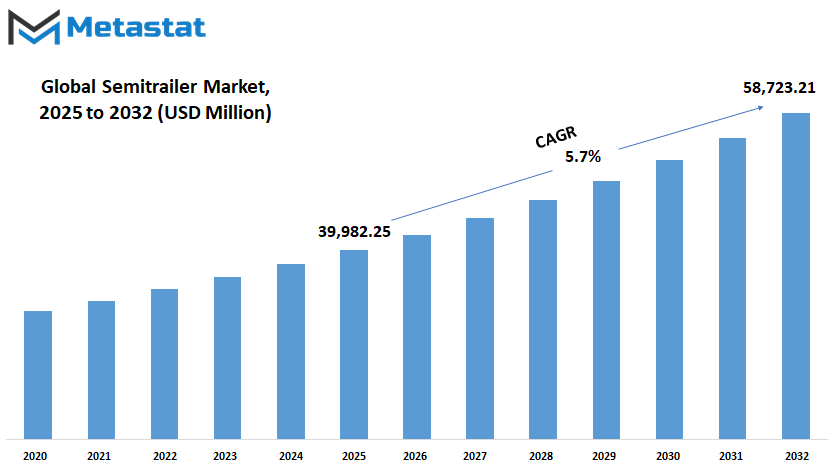
GROWTH FACTORS
It is projected that the Global Semitrailer market would grow extensively in the years to come on account of some of the following factors. Most significantly, such growth can be attributed to the increasing demand for efficient transport solutions. However, with companies growing and global trade becoming more intertwined, the reliability and high-capacity freight vehicles would see a rise in demand.
Transporting a large amount of goods over long distances is semitrailers' forte and for this reason, it is widely used within logistics and supply chain operations; such increased demand is likely to cause manufacturers trade innovations and improvements in the design and performance of semitrailers to match the constantly changing and emerging transportation needs of the sector.
Another factor affecting the growth of the Global Semitrailer market is advanced technology developments. Automation, telematics, and advanced safety features become integrated in the modern semitrailer. They operate efficiently and will reduce the operational cost of the transportation system. Furthermore, the impact of these innovations is manifested not only in the overall performance of the vehicles but also in its better monitoring and management of fleets.
With smart systems incorporated in semitrailers, businesses will be enabled to get track of the shipment in real time, reduce time loss, paying attention to optimizing delivery routes. Such technical innovation is believed to be a great contributor in changing the future of this market.
The bright side of the Global Semitrailer market suggests that, like any progressive activity, it will have some challenges slowing down its growth. A major turn off in progress is that of rising fuel prices. Since semitrailers largely depend on diesel and other fuels, instant alterations in fuel costs can upraise operating expenses greatly. In the same way, environmental regulations are becoming stricter worldwide, compelling industries to turn to cleaner and greener alternatives.
Such conversions incur higher costs in investments on alternative fuel technologies and low-emission vehicles, which would be considered to be a burden for manufacturers and fleet operators.
Another most likely obstacle to the growth of the market may be the shortage of skilled drivers. Thus increasing the demand for semitrailers, would increase the demand for trained mothers who would have to serve the long hauls. However, the industry has since had challenges in recruiting and retaining the drivers, a situation that could lead to delays and increased operational pressure on the existing workforce. Solving this problem is likely going to entail improvements in working conditions, better training and higher pays.
On the positive side, the increased emphasis on e-commerce and expanding global supply chains will definitely add some exciting opportunities in the future for the Global Semitrailer market. The increased reliance on online shopping means better and faster delivery systems will be in demand.
This means that demand for semitrailers will go up, replacing existing systems that transport perishable and highly valuable products with modern and automated semitrailers. Those manufacturers and logistics companies investing in new trailer designs and improved storage capabilities will most likely benefit from this trend in the years ahead.
The future of the Global Semitrailer market in terms of technological advancement and increasing need with changing challenges and requirements is quite a situation. Hence, if innovative practices with key issues are addressed, the industry can grow steadily while playing a significant role in developing the global transportation network.
MARKET SEGMENTATION
By Type
As the industries worldwide keep growing, subsequently giving the rise in consumer demand, the need for such advanced and specialized semitrailers is expected to grow because they are going to be required in increasingly large numbers. This type of growth is driven by technological advancements and changing business needs, as well as sustainability considerations.
This is one thing that could change the scenario about the future of Global Semitrailer markets; the variety of types of semitrailer available to suit all purposes. The most commonly used would be dry van semitrailers, which are enclosed in space that protects goods against weather and damage. Such courses are perfect for non-perishable items along with general cargo, forming an integral part in most industries.
In contrast, refrigerated semitrailers have temperature-controlled environments useful in transporting perishable products such as food and medicines. The more the demand of the world skyrockets for fresh and frozen products, the more the importance of these refrigerated units grows.
Tanker semitrailers are specialized one’s designed to carry liquids, gases, and chemicals. Because of their very robust construction and safety features, they have become indispensable for the industries such as oil, gas, and agriculture. Flatbed semitrailers do the same, and they are designed for making an open platform, perfect again for using heavy and oversized loads that cannot be fitted in standard enclosed trailers. Their multifunctional quality comes especially handy in the construction and manufacturing sectors.
Lowboy semitrailers have been developed to accommodate extremely heavy equipment and are used mainly for construction and industrial work. These have a low deck height to accommodate tall machinery that can otherwise be carried only because it becomes safe and much more convenient in transportation. Adaptable to businesses where fast loading and unloading is of essence, this type of semitrailer has side panels that can be drawn back for easy access. It is especially useful for side-loading goods by forklift.
Other types of semitrailers are still coming up, and thus they offer tailor-made solutions for unique industries. With modern technology means that they will have features such as better safety for cargo, greater fuel efficiency, and smart tracking devices which will not only be common but will also drive the innovations for electric or hybrid semitrailers.
Thus, the future of the Global Semitrailer market looks bright because of the increasing demand for efficient transport, evolving requirements of the industry, and the pace of technological advancement. Further diversification of semitrailers in configurations and technology in the future will ensure a steady market expansion as companies search for ever more sophisticated logistics solutions.
By Length
The semitrailer business in the world is sure to have a good future after some years considering how much the demand will grow for even more efficient and flexible transportation solutions. At the same time, it is going to be an important enabler to ensure safe, smooth, and efficient movement of goods as industrial activities develop around the need for more reliable logistics.
These large, unpowered trailers attached to trucks are used to transport almost everything over long distances. They are made really adaptable with the continuous design and technological advancements, which also allows for greater capacity and longer durability.
Most importantly, the future of the global semitrailer market will be conditioned by the division of trailers according to their length into up-to-45-feet trailers and above 45-feet trailers. The need for both types varies with the end use and type of cargo. Semitrailers below 45 feet are mostly preferred for urban delivery and shorter routes.
Their smaller dimensions make inner-city maneuvering easier, making them ideally suited for distribution in high-population areas. These offer the right balance for full payload to ease of handling; thus, the other factor for the preference is convenience of access and exit, usually with a high loading and unloading frequency.
However, semitrailers above 45 feet long are used for goods transport over long distances and heavy-duty logistics. Such trailers can carry more goods in a single trip or fewer journeys and are therefore cost-effective in moving voluminous goods.
With the progressive growth of global trade and an increasingly interconnected supply chain, it is inevitable that such larger trailers would be in greater demand. These are particularly useful by industries such as manufacturing, retail, and agriculture, wherein some bulk moves are standard requirements.
The technological change is hence going to also affect the global semitrailer market very greatly. Major investments are headed towards enhanced safety features, superior fuel efficiency, and intelligent systems that allow for real-time tracking and load management. Use of lightweight materials for increasing payload capacity without compromising structural strength with aerodynamics improvements leading to reduced fuel consumption. Transportation cost is thus reduced and is also in line with the global agenda of carbon emission reduction.
The global semitrailer market will now evolve and grow again. Whatever be the reason for that-the increased use of shorter trailers for urban logistics or the use of larger trailers for cross-country transportation-there will be an increase in demand for these flexible machines. There will still be continuance for semitrailers in the global supply chain with the progress of technology and changing needs of the industry.
By Tonnage
Semitrailers are an essential component of the logistics chain, providing a highly flexible way of transporting goods across long distances, and their predominance is expected to further increase with the changing landscape of international trade and commerce.
One major factor segmenting the global semitrailer market is the tonnage classification. Whereas one industry may need the semitrailer for one ton of load capacity to fulfil its transportation needs, others may require totally different loads to work with. The semitrailer market is segmented as follows according to tonnage: below 25 T, 25 T to 50 T, 51 T to 100 T, and above 100 T. Each classification serves a different purpose and type of cargo; hence this segmentation is key in developing market intelligence on trends and projections.
Semitrailers falling into the category below 25 T are commonly used for light loads over short distances. These semi-trucks offer flexibility and are more apt for urban deliveries or small businesses that do not require heavy freight movement. With the ongoing growth of e-commerce, combined with increasing last-mile delivery demands, this sector is expected to enjoy steady demand.
The 25 T to 50 T semitrailer class finds several applications across industries and is often chosen for medium-weight goods. It balances the issues of capacity versus efficiency and is useful for regional transportation. Using this class of semitrailer, one can load almost anything from consumer goods to construction materials. With ongoing infrastructure development worldwide, this segment is expected to retain its importance in the market.
The semitrailers range from 51 T to 100 T designed for hauling heavy loads across long distances. These semis are commonly applied in manufacturing, mining, and heavy construction environments that frequently deal with bulk shipments. Given that new technologies are making these semitrailers much more efficient, with safety being one of its top features, demand is likely to grow for higher-than-usual semis.
Above 100 T is the most powerful and heavy-duty category of semitrailers that can haul oversize or exceptionally heavy cargo. This installment is quite important for specialized industries that require loading and hauling heavy equipment or machinery. The global demand for high-capacity semitrailers will likely grow further with the expansion of industrial projects.
The global semitrailer market will continue to change in response to industrial developments and advances in transportation technology. In its capacities to meet different tonnage requirements, the semitrailer really provides backbone support to global logistics and supply chains-a segment destined for a sunny future in the transport industry.
By End-Use
In the near future, the overall growth of the global semitrailer market is fuelled by increasing requirement from diverse sectors. A semitrailer is essential for long-distance transport of goods and makes a vital part of the supply chain system worldwide. As industries expand and logistics complexity increases, the demand for reliable and flexible transportation solutions would further increase. This growth will be directed by variable industry requirements, advancement in technology, and a perceptible drive towards more efficient and sustainable logistics.
The segment of end-use sectors using semitrailers varies widely and is among determining factors for the global semitrailer market. Heavy industries, which constitute the primary end users of semitrailers, make use of them to move machinery and material from one place to another; they need a robust and durable transport solution that can deal with very significant weight and have to suffer some very demanding conditions. As this new heavy specialized semitrailer comes into its own with the growing infrastructure projects globally, so, too, will the growth in industrialization projects.
Fast-moving consumer goods (FMCG) are another important segment which makes use of semitrailers for their logistical operations. The FMCG sector just needs a very efficient timely transportation mode so that their products can be brought into the retailers or at the consumer level without being delayed. There exist quick deliveries propelled by the emergence of e-commerce in combination with the increased consumer demands on a reduced time taken within delivery.
Hence, high-speed and high-volume distribution semitrailer systems would be highly essential under such circumstances. These situations will therefore contribute toward molding future innovation trends on design and functionality of the semitrailers.
The presence of the chemical industry is another trend shaping the global semitrailer market. Transporting chemicals often requires special equipment designed for the safe handling of hazardous or sensitive materials. Semitrailers designed for this purpose must meet stringent safety standards and offer features that prevent leakage, spillage, or contamination. Demand for the advanced and safety-focused semitrailers will continue to gain traction with the increasing global demand for chemicals.
The automotive sector comprises a vital part of the market, which uses semitrailers for transporting vehicles and automotive parts. There would be a significant demand for customized solutions from the automotive industry regarding electric and autonomous vehicles. Good transit of both vehicles and components with no damage will remain a major concern, encouraging new developments in the design of semitrailers with increased safety and handling features.
The oil and gas sectors rely heavily on semitrailers for transporting equipment, materials, and finished products. Because of the remote locations and extreme climate conditions that generally characterize oil and gas operations, semitrailers used in this sector have to demonstrate enhanced durability and performance. With alternative fuels and renewable sources being studied within the energy sector, greater variability in material and equipment for transport will become evident, thus requiring further adaptability and innovative designs within the semitrailer sections.
The need for semitrailers in this specific sector includes the safe and timely delivery of medical supplies, equipment, and pharmaceuticals. This integrity of the product during transportation is of prime importance, especially for temperature-sensitive items such as vaccines or biologics. Hence, increasing demand in the global health care sector will make semitrailers provided with advanced climate control and monitoring systems critical.
Apart from these, retail, agriculture, and construction will also find special places in contributing to the market growth of semitrailers globally. Each of these areas has specific transport requirements, and therefore, larger variety types and features called for increased variety types and features on semitrailers would be generated through their demand. The more supply chains become interconnected and efficiency-driven, the more semitrailers will serve in ensuring an uninterrupted logistics process.
From the perspective of developments in technology and changing industry demands, the global semitrailer market would still be evolving in the future. Future developments like electric-powered semitrailers, better telematics, and autonomous driving abilities will ensure a different dimension of goods transport. With different economies striving toward more efficient, safe, and sustainable logistics solutions, semitrailers will always be at the core of these efforts, changing with time to meet these needs of the rapidly changing global landscape.
|
Forecast Period |
2025-2032 |
|
Market Size in 2025 |
$39,982.25 million |
|
Market Size by 2032 |
$58,723.21 Million |
|
Growth Rate from 2025 to 2032 |
5.7% |
|
Base Year |
2024 |
|
Regions Covered |
North America, Europe, Asia-Pacific, South America, Middle East & Africa |
REGIONAL ANALYSIS
The global semitrailer market is shaped by multiple regions, each playing an important role in its future growth and development. As the demand for efficient transportation keeps on increasing, the market becomes potentially viable in different parts of the world, due to advancement in infrastructures, trade, and logistics. North America emerges as an important region, with the U.S., Canada, and Mexico contributing greatly.
The well-established transportation network in the region and a growing demand for durable and high-capacity trailers are helping drive market growth. The U.S., in particular, will probably remain the biggest contributor due to the booming logistics industry and the emphasis on technological innovation in vehicle manufacturing.
In Europe, the market is shaped by countries like the UK, Germany, France, and Italy along with the rest of Europe. The enhanced freight transport efficiency in Europe along with the demand to reduce carbon emissions urges banks to invest in the latest energy-efficient semitrailers.
Cross-border trade and e-commerce are other factors supporting the demand for semitrailers, making Europe a key component in the market future. With vehicle fleet upgrades ongoing throughout Europe, the implementation and introduction of advanced semitrailer designs will witness a boost.
Asia-Pacific seems to be in for maximum growth with countries like India, China, Japan, and South Korea being at the forefront. This region has opportunities for this market because of rapid industrialization, expanding manufacturing sectors, and an increase in demand for goods transportation. The growth of global trade with China and a burgeoning logistics industry in India will aid in the expansion of the market. Furthermore, growth will also accelerate as the regions call for better road infrastructure and the adoption of advanced vehicles.
The South American territory makes a notable contribution to the global semitrailer market with Brazil and Argentina at the forefront. Demand for quality semitrailers rises in these countries as they invest in transportation infrastructure and strengthen logistics capabilities. Agricultural and industrial exports from the region also push the need for reliable freight solutions, positioning it as a crucial market segment.
In the Middle East and Africa, GCC countries, Egypt, and South Africa form promising markets. The ever-increasing construction activities, rising imports and exports, and infrastructure development are factors triggering the demand for semitrailers. And with the upgrading of the logistics network in these regions, there is more call for advanced trailer equipment.
In general, it can be stated that worldwide semitrailer markets will keep on growing as regions around the world upgrade logistics and transportation capabilities. Each region possesses its own strengths and is in continuous development, lending an impact to the market future, thereby opening up innovation and growth avenues.

COMPETITIVE PLAYERS
The significant transitions awaiting the way of the Global Semitrailer market in the coming years would be the evolution of transport needs as they brought about technological advancement and the increasing demand for logistics solutions. Their market fate will then largely be determined by key players within the industry who innovate and adapt to their ever-changing economic and environmental conditions. Playing a crucial role in defining the industry standards, introducing new designs, improving operational efficiency, these descriptions paint for us a dynamic yet challenging competitive environment.
Schmitz Cargobull AG stands as a leading company in the industry regarding high-tech and high-quality manufacturing; with its durable and innovative semitrailers, it has maintained the frontier of this industry. Wabash National is well known for consistently creating transportation equipment that is reliable and efficient while stretching the limits on design and performance. The Krone Commercial Vehicle Group is also a leading competitor because it is known for its customer-driven attitude and exacting standards in quality.
A few other significant players with established niche offerings are INOXCVA and SDC Trailers Ltd. INOXCVA is also famous for talking about design innovation with specific applications, but there is a lot of attention given to SDC Trailers Ltd, whose sales pitch is based on highly customizable products with rugged construction. Group Schwarzmüller or Lamberet SAS bring further variety to the market with their unique perspectives on trailer building, coupled with high quality. They are major contributors to the growth of the market because they can adapt easily to changing demands and offer flexible solutions.
CIMC and Stoughton Trailers also add to a much broader and diversified portfolio with their extensive global networks, as well as a range of products. Enriching the scope and efficiency of its semitrailer offerings is MAN SE by leveraging its automotive expertise. Foshan Ultraton Engineering Machinery Co., Ltd. and Kässbohrer add to the competition with their engineering innovations and commitment to safety and durability.
These companies will likely be focusing on smart technology in the name of their future global semitrailer journeys, then coming up for improvement along the levels of reducing carbon emissions, and enhancing operational efficiency. Predicting the market trends as well as investing in research and development will form the basis of their competitive edge. Logistics and transport will not stop evolving, and thus, the industry leaders will continue to be instrumental in shaping the future of the semitrailer market.
Semitrailer Market Key Segments:
By Type
- Dry Van Semitrailers
- Refrigerated Semitrailers
- Tanker Semitrailers
- Flatbed Semitrailers
- Lowboy Semitrailers
- Curtain Side Semitrailers
- Other
By Length
- Up to 45 Feet
- Above 45 Feet
By Tonnage
- Below 25 T
- 25 T-50 T
- 51 T-100 T
- Above 100 T
By End-Use
- Heavy Industry
- FMCG
- Chemical
- Automotive
- Oil & Gas
- Healthcare
- Other
Key Global Semitrailer Industry Players
- Schmitz Cargobull AG
- Wabash National
- Krone Commercial Vehicle Group
- INOXCVA
- SDC Trailers Ltd.
- Schwarzmüller Group
- Lamberet SAS
- CIMC Vehicles Group
- Stoughton Trailers
- MAN SE
- Foshan Ultraton Engineering Machinery Co., Ltd.
- Kässbohrer
WHAT REPORT PROVIDES
- Full in-depth analysis of the parent Industry
- Important changes in market and its dynamics
- Segmentation details of the market
- Former, on-going, and projected market analysis in terms of volume and value
- Assessment of niche industry developments
- Market share analysis
- Key strategies of major players
- Emerging segments and regional growth potential



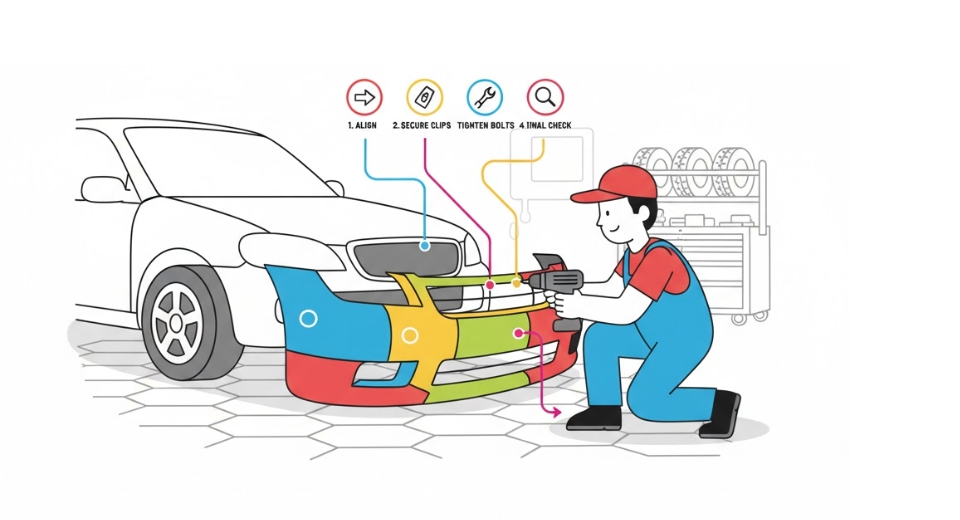
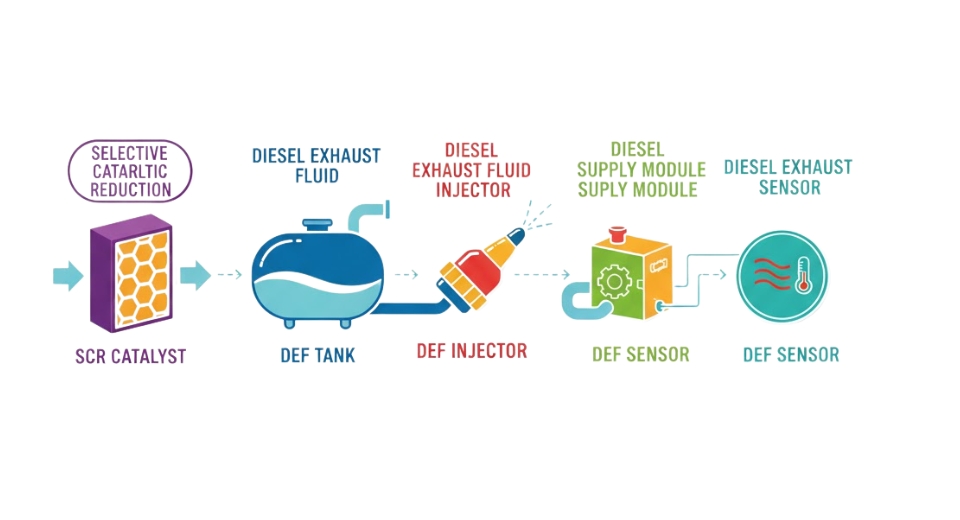
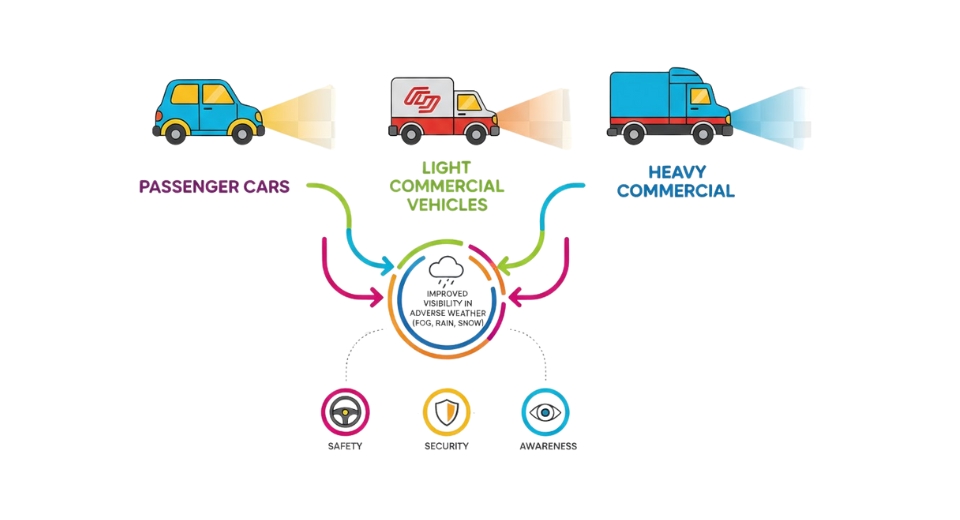
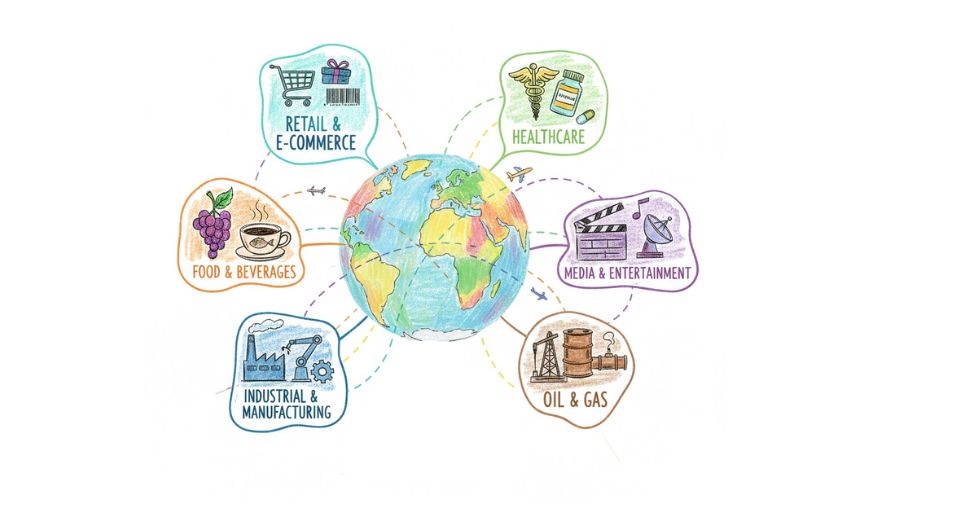

 US: +1 3023308252
US: +1 3023308252






